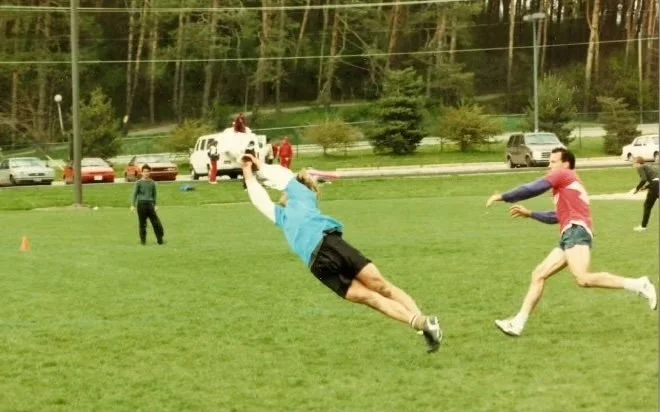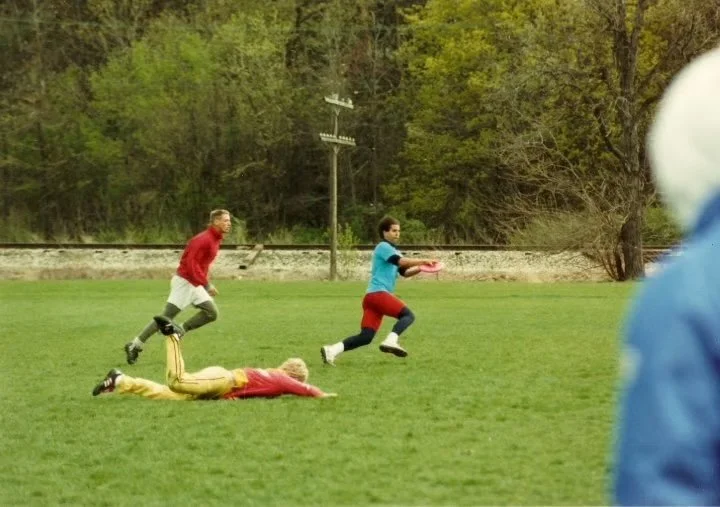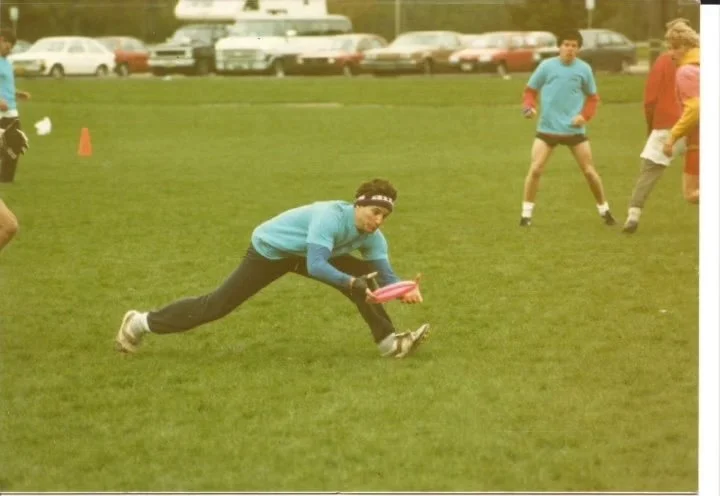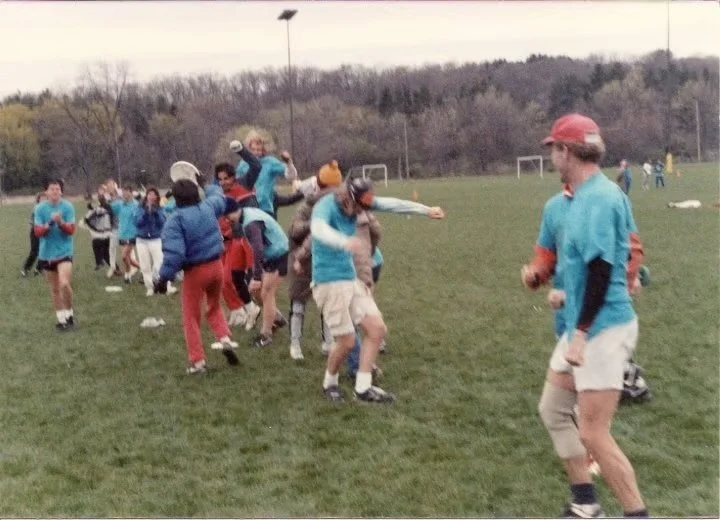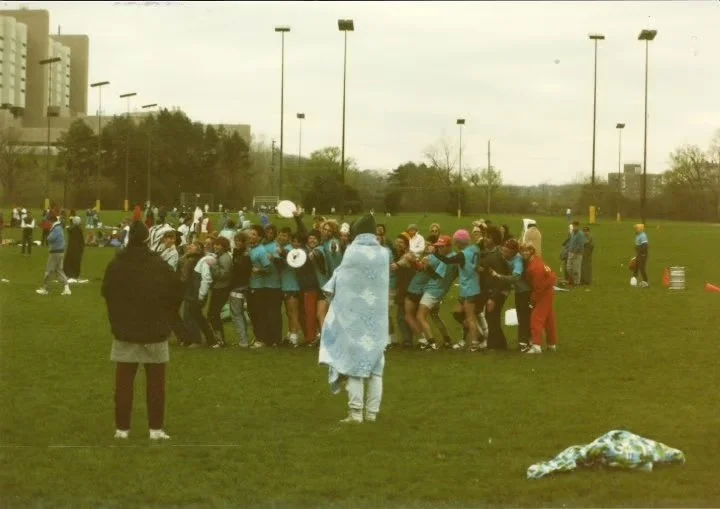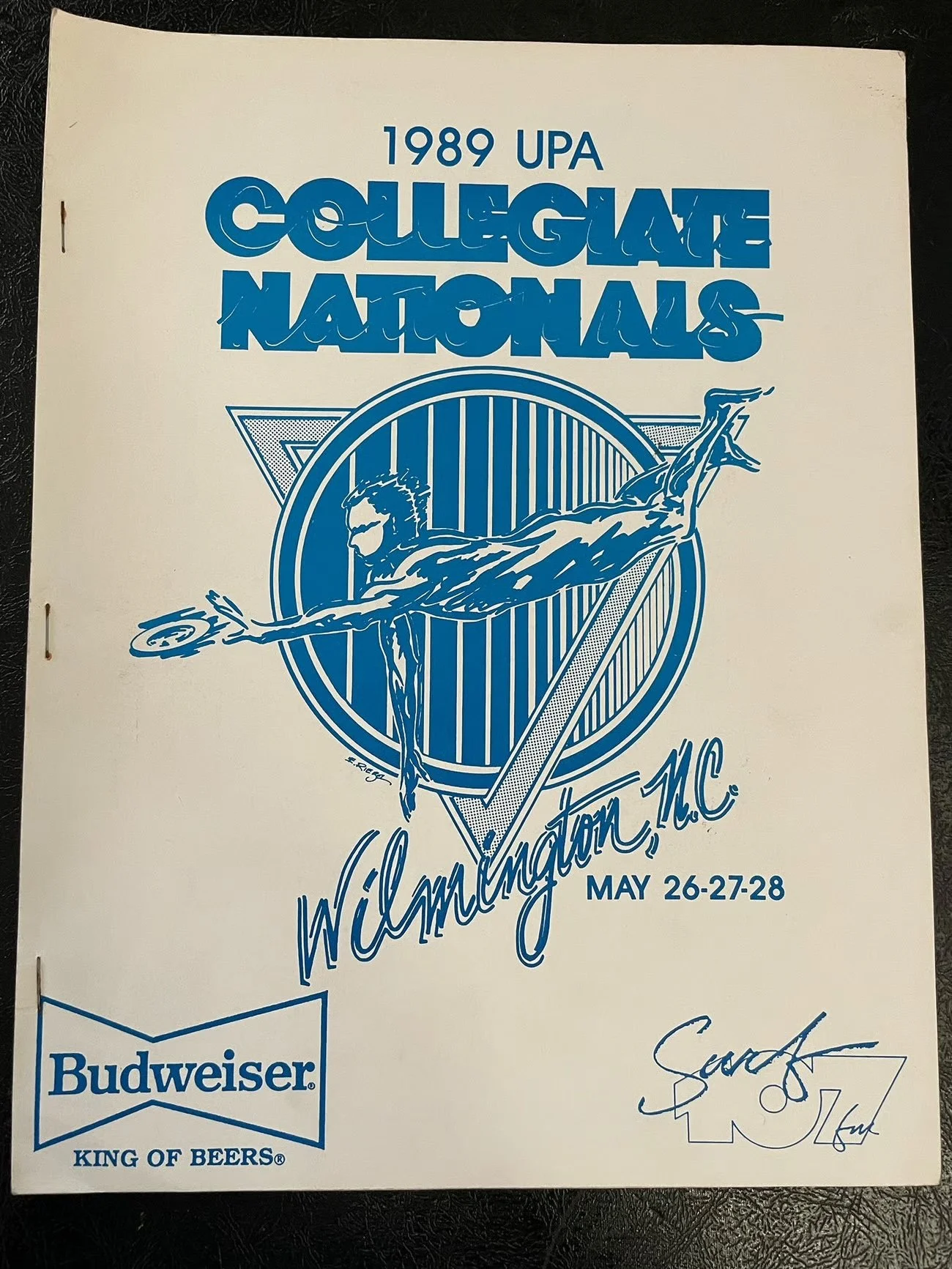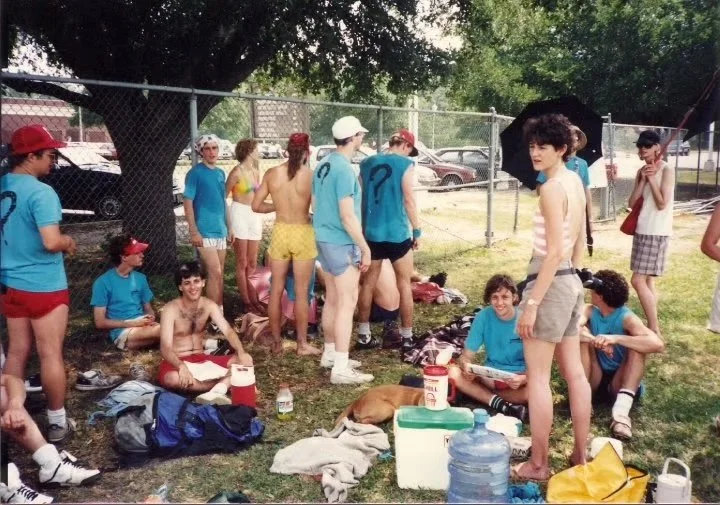Part 3: The Nationals Year (1989)
The Undefeated Season & The Road to Nationals
By 1989, the HoosierMama?s weren’t just another college ultimate team. They were playing at a level no IU team had reached before.
After years of scraping for wins, learning through heartbreak, and slowly building something bigger than themselves, the Mama?s entered the season with one mission:
Make Nationals.
This is the story of how they went undefeated in regular college season play, fought through one of the most grueling “Game to Go” matchups ever, and finally earned their place on the sport’s biggest stage.
This is Part 3 and the final of our three-part series diving into how the Mama?s went from a ragtag group playing in Dunn Meadow to a Nationals-caliber program. If you missed Part 1 or 2, click the links below.
Let’s dive into the final leg of the journey...
The 1989 season started with one goal: Nationals.
For years, the Mama?s had fought for legitimacy, scraping their way up from a team that struggled to keep enough players at practice to one that had proved they belonged at Regionals. But belonging wasn’t enough anymore.
Now, they were ready to dominate.
And from the moment the season started, they did.
The Mama?s stormed through their schedule undefeated vs. college teams. Every game, every tournament—it didn’t matter who they faced. They had answers for everything.
Chuck Powell and Mark Veldman vs. Austin at the 1989 St. Louis Classic
“We weren’t just playing well,” Mark Veldman says. “We were in control of every game. We dictated the pace, we forced teams into mistakes, and we punished them when they did.”
The turning point came at the Big Ten Tournament in Madison, Wisconsin
Unlike Regionals, which featured the best teams in the Midwest, this event had a mix of college and club teams. It was a perfect test for where they stood—and they rose to the challenge.
Team huddle at the 1989 St. Louis Classic
After a tight, back-and-forth first half, Kansas began to take control.
They led 9-12.
They moved the disc efficiently, kept possessions clean, and capitalized on every mistake. Meanwhile, the Mama?s—so dominant all season—found themselves on their heels for the first time in months.
The semifinal against Czech Ultimate—the #2 club team in Chicago—was a defining moment.
For years, the Mama?s had been just short against Czech. They had played them 3-4 times throughout 1988, always losing by 3-5 points. The games were close, but Czech had always been a step ahead.
This time, things were different.
“It was a windy, brutal game, and we had never beaten them before,” Tim Anderson remembers. “But we were more disciplined than ever. We didn’t make dumb mistakes.”
With Andy Malone finally playing full-time, the Mama?s matched Czech point for point.
Then, universe point.
The Mama?s needed to score upwind, an almost impossible task in the bitter cold and swirling wind.
Rich Hollingsworth had the disc. “I was good at getting off my backhand pretty close to the ground, and I managed to get it past the mark toward Jeff [Behrends], cutting to the left, front corner,” he recalls. “When the disc was halfway there, I thought, ‘Well, I turfed that one…’”
But somehow, the disc kept flying.
“Then I thought, ‘It’ll be a miracle if Jeff digs this out.’”
And then, he did.
In one moment, the Mama?s had finally taken down their nemesis.
Final score: 13-12.
The Mama?s advanced to the finals—where they faced Budda, one of the top club teams in the region.
“We lost 16-14, but we played them close,” Anderson says. “That tournament made us believe. We weren’t just trying to qualify for Regionals anymore—we were trying to win.”
And that’s exactly what they did at Sectionals.
Sectionals 1989, West Lafayette, IN
In April 1989, the Mama?s arrived at College Sectionals at Purdue with one thing on their minds—win the whole thing.
They didn’t just win—they dominated.
🔥 Crushing teams left and right.
🔥 Executing their game plan to perfection.
🔥 Never letting up.
“The only team that gave us any trouble was Earlham,” Rich recalls. “Randomly, they pushed us a bit, but other than that, we controlled every game.”
By the end of the weekend, the Mama?s had secured their first-ever Sectionals title.
But the real test was still ahead—Regionals.
Team Photo at the 1989 St. Louis Classic
The Road Through Regionals: Taking Control
By the time the Mama?s arrived at Regionals in Ann Arbor, Michigan, they weren’t just another team in the bracket.
They were the team to beat.
🔥 A #2 seed, with a full roster ready to make history.
🔥 A defense that suffocated teams.
🔥 An offense that picked opponents apart.
And from the first pull, they played like it.
Game one? A statement win against a lower seed.
Game two? Handled St. Louis University with ease.
Semifinal? A battle against Carleton—but a five-point win sealed it.
They were one win away.
One game from Nationals.
The Game to Go: A 3-Hour Battle Against Kansas
The conditions at Regionals were brutal. A stiff wind cut across the fields, making throws unpredictable, and the temperature hovered in the uncomfortable range between chilly and just warm enough to sweat through your jersey. Every point was going to be a grind.
And then, of course, there was Kansas.
They weren’t just a tough opponent. They were the team. The regional powerhouse. They had been here before, year after year, always finding a way to win and punch their ticket to Nationals.
Dan Kelly scoring a goal vs. Kansas in the Regional final.
“Kansas was just more polished,” Rich Hollingsworth recalls. “They didn’t beat themselves. We had been in control all season, but against them, every little mistake mattered.”
The sideline energy dipped. Kansas smelled blood. The Mama?s needed something—anything—to shift the momentum.
And then, it happened.
The Defensive Play That Turned the Game
The Kansas offense worked methodically down the field. The disc swung from sideline to sideline, stretching the Mama?s defense. Then, a Kansas cutter broke deep.
The throw went up—a long, floating huck with the wind carrying it. For a second, it looked like an easy score.
Then, Mark Veldman took off.
Mark Veldman laying it all out on the line in the1989 Open Regionals Final vs. Kansas
He covered the last ten yards in a full sprint, then launched himself into the air—completely horizontal, fully extended. His fingertips met the disc just before the receiver could close his hands around it.
A clean block.
The disc hit the ground.
Silence for a split second—then the sideline exploded.
“That was the moment,” Tarpey says. “That was when we knew we were still in it.”
It wasn’t just that they got a turnover. It was how.
It was a message.
Kansas wasn’t going to cruise to another Nationals bid.
The Mama?s weren’t backing down.
“We weren’t thinking about Nationals anymore. At that point, it was just, ‘Find a way to win this next point.’ ”
Trading Punches in a War of Will
The Mama’s chipped away.
🔥 They tied it at 12-12.
🔥 They took the lead at 13-12.
Kansas responded.
🔥 Tied 13-13.
🔥 Tied 14-14
Both teams were grinding out every point. Every cut, every throw, every mistake felt magnified.
And then, at 16-16, the captains met at midfield.
They agreed: Win by two.
There was no cap, no quick way out. The game would go as long as it needed to.
What followed was one of the longest, most exhausting, most emotionally draining stretches of ultimate in Mama?s history.
Chuck Powell scoring a goal vs. Kansas in the Regionals Final.
Mike Pieri catching a disc vs Kansas in the Regionals Final
🔥 17-17.
🔥 18-18.
🔥 19-19.
For over 30 minutes, neither team budged. The wind was relentless. Players were cramping, bleeding, gasping for air between points.
“We weren’t thinking about Nationals anymore,” Tim Anderson recalls. “At that point, it was just, ‘Find a way to win this next point.’”
On the sidelines, players stood with their hands on their knees, too nervous to sit. Every possession felt like the one that would decide the game.
And then—finally—the Mama?s broke through.
A sharp inside flick found an open cutter in the end zone.
20-19.
The sideline buzzed, waiting for the finish.
Kansas worked the disc upfield, playing conservatively, carefully. They weren’t going to give the game away.
Then, on a crucial reset, the Mama?s pounced.
A hard mark, a pressured swing pass—and a layout D from Tarpey.
Suddenly, the Mama?s had the disc with a chance to win.
One clean dump. A swing to the break side. A quick dish to the front corner of the end zone.
Score.
Final score: 21-19.
The field erupted. Players collapsed, some from exhaustion, some in disbelief.
“It was just… pure release,” Anderson says. “We had worked for years for this moment. And now it was real.”
🔥 The HoosierMama?s were going to Nationals. 🔥
Jeff Behrends laying out for a catch vs Kansas in the Regional Finals
The moment the Hoosiermama?s punched their first ticket to Nationals.
Richard Hollingsworth reacting to the moment.
Richard Hollingsworth in tears of joy.
HoosierMama?s celebrating their first ever trip to Nationals.
The Nationals Experience: A Harsh Reality Check
The celebrations lasted through the night, but soon, reality set in.
The team had less than two weeks to prepare for the biggest tournament of their lives.
“We weren’t just going to another tournament,” Hollingsworth says. “We were going to play against the best teams in the country.”
When the Mama?s arrived in Wilmington, North Carolina, the scale of it all hit them immediately.
The fields were pristine, lined with teams they had only heard about. Players from powerhouse programs moved differently, threw differently, played the game at a level that was instantly unrecognizable.
For years, the Mama?s had been the scrappy, upstart team. Now, they were the newcomers.
1989 UPA Collegiate Nationals Program
Mama?s at their first ever Nationals in Wilmington, NC - 1989
Their opening round matchups were a baptism by fire.
🔥 They lost two games by just two points (17-15).
🔥 They fought hard, but against the top-tier teams, every mistake was punished.
🔥 They finished winless at Nationals, but they weren’t outclassed—they were right there, on the verge.
“It was frustrating,” Anderson admits. “We knew we were close. But Nationals was different. You could feel it in every throw, every cut.”
Still, there was no shame in the result.
🔥 The Mama?s had made it.
🔥 They had proved IU Ultimate belonged.
🔥 And they had set a new standard for every Mama?s team to come.
The team that made history.
The Legacy of 1989
That season changed everything.
The Mama?s weren’t just a fun club team anymore.
They had put IU Ultimate on the map.
🔥 They were a Nationals program now.
🔥 They had taken down giants.
🔥 They had fought for every inch of that moment.
And 40 years later…




